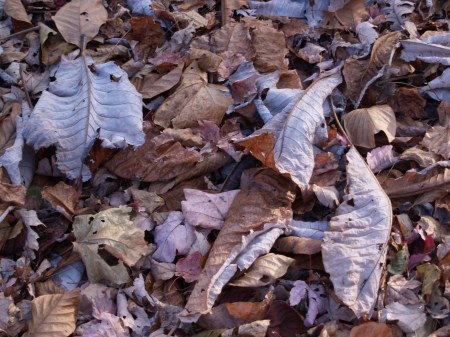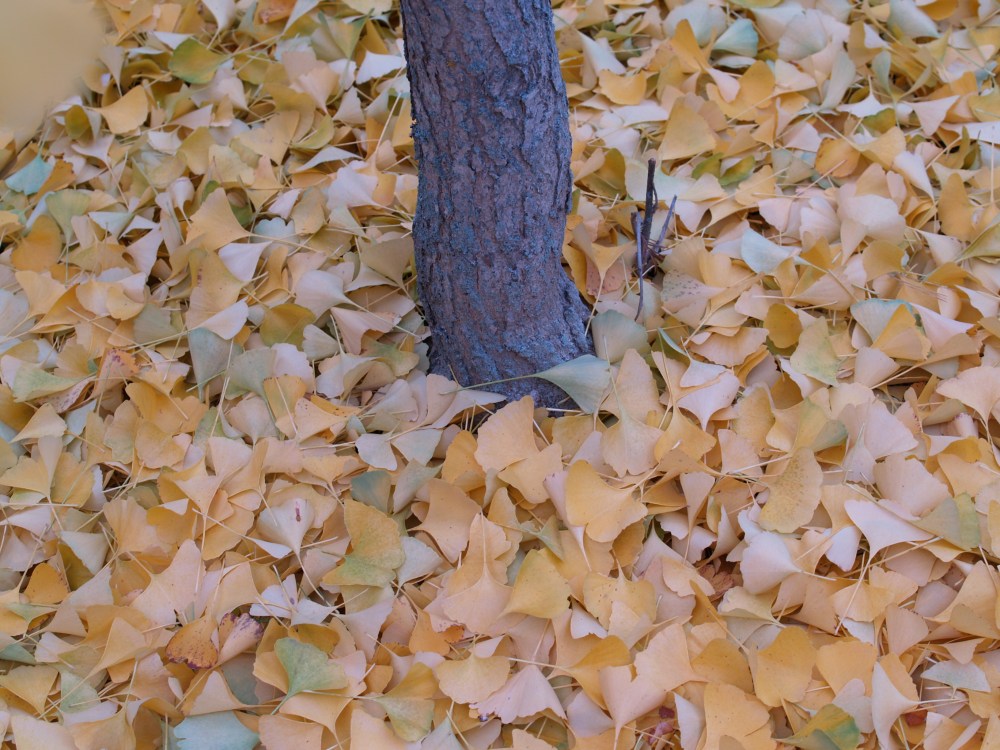I know gardeners who are deeply disturbed by any accumulation of leaves in the autumn months. Their gardens must remain tidy, so leaves are raked or vacuumed promptly. If you’ve visited these pages before, I’m certain you’ll not be surprised to learn that I’m not bothered at all by large piles of leaves. I must delay until every last leaf has fallen before beginning to rake and shred since I’ll only be motivated to do this once.
Today, the driveway is mostly covered with leaves from the magnolia, golden rain tree, hornbeam, and Japanese maples, and maple and sycamore leaves have blown in from the neighbors’. I’ll get around to these, maybe this weekend or the next, and surprisingly my wife has not yet insisted that the garage door be kept closed to prevent leaves from blowing in. She closes the door, then I follow immediately behind to open it since it’s a pain to wait every time I go in and out.
The stone paths that wander through the garden are gone, buried under inches or feet of leaves. It seems an immense luxury as I kick through the leaves as I stroll through the garden on those few evenings when I return home from work before dark. Every day that the chore of cleaning the leaves is delayed is a gift, since gathering and shredding leaves on an acre of garden that borders a forest is not accomplished quickly.
If there was more lawn the task would be simpler. I would happily mow the lawn to pulverize the leaves as frequently as necessary. But, there’s little lawn, and lots of garden, which complicates the process. I’ll admit that there have been times when I simply put the whole thing off, intending to do it, but never quite getting around to it. This inevitably leads to trouble.
Small perennials, and particularly the hellebores that I treasure so much for their late winter blooms, do not appreciate being buried under a foot of leaves. It’s not so bad in November when the leaves are dry and loose, but after repeated winter rains and occasional snow the leaves become wet and densely packed. Then, they are much more difficult to rake and remove, and when some of the clean up is delayed into February (or sometimes March) it requires double the labor.
I often get stuck in the middle so that the worst of the leaves are cleared from the driveway, the paths, and patios, but I get lazy when it comes to the larger areas of garden where leaves have piled the deepest. This part of the garden runs alongside the forest, and rather than spending half my life raking, I use a gas blower to vacuum and shred the leaves. Nothing is bagged. The leaves go into the shredder whole, and go out the back end as mulch. This seems easy enough, but my consternation stems from small twigs that constantly clog the blower so that I must stop every minute or two.
Sometimes I give myself credit for being very patient, and other times it’s obvious I’m not, but when I have a lengthy task at hand, admittedly my fuse runs short. I can take only so much of the clogging and cleaning of the blower before I’m inclined to call it a day, though I remind myself that the job will be ever so much more difficult if I delay and allow the leaves to become wet and matted. I debate this with every twig that causes the vacuum to grind to a halt, and finally the voices in favor of calling it quits win out. If tomorrow is Sunday, maybe there’s a chance to pick back up where I left off, but if it’s a back to work day the clean up might be delayed for another few weeks, or months.
A winter mulch is my friend!
For much of my garden shredded leaves are the only mulch. Since they break down by mid spring they’re not so good for keeping weeds down (except through the winter), but the plants sure do appreciate them.